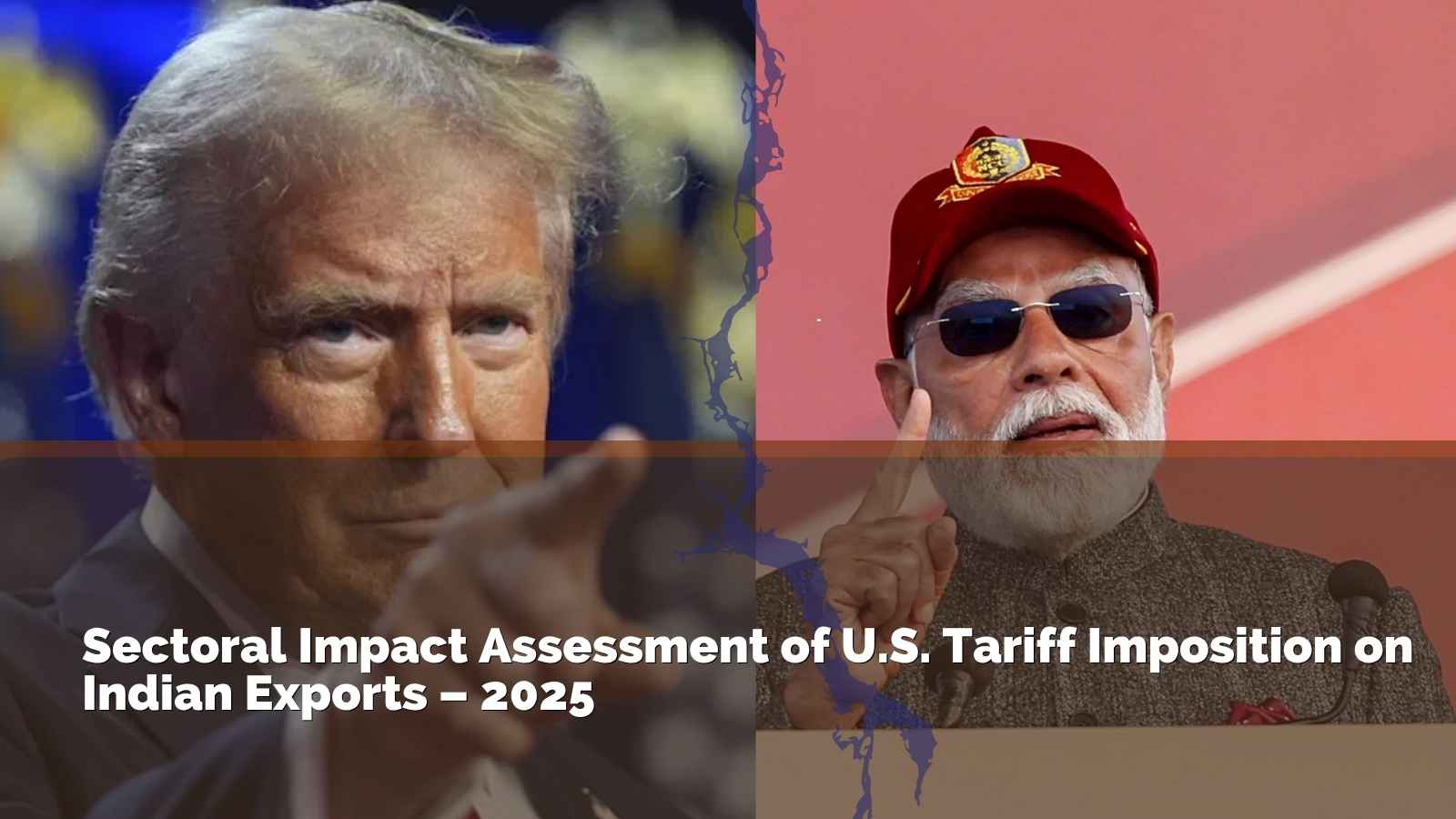30th July 2025, India
Indian Exports Face 25% U.S. Tariff Amid Rising Geopolitical Tensions
In an escalation of a major trade war, U.S. President Donald Trump declared imposing a 25% tariff on Indian exports to the U.S. effective from August 1, 2025. It is part of a broader policy response to India’s trade conduct and its continued economic engagement with Russia, particularly in the energy sector.
President Trump further implied that India will have to pay additional duties beyond the regular tariff, observing that the country is still bringing in Russian crude oil as the protracted war in Ukraine is still ongoing. The steps will have significant implications for Indian exporters and for two-way trade relations.
At most 10% of India’s total exports can be impacted during the July to September quarter of 2025 if the effective tariff rate is greater than 25%.
The U.S., to which 17.7% of India’s exports in FY24 were going, remains India’s largest export destination. The additional tariffs will have a significant impact on a variety of industries such as electronics, jewellery, chemicals, and pharmaceuticals.
Top Indian Exports to the U.S. – FY24 Snapshot
|
Category |
Export Value |
Share of Total U.S.-Bound Exports |
|
Electronics |
$11.1 billion |
14.3% |
|
Gems & Jewellery |
$9.9 billion |
12.8% |
|
Pharmaceutical Products |
$8.1 billion |
10.4% |
|
Nuclear Reactors & Machinery |
$6.2 billion |
8.0% |
|
Refined Petroleum Products |
$5.8 billion |
7.5% |
U.S. Expands Trade Pressures: Sanctions on Indian Firms Over Iran Oil Trade
In addition to the 25% tariff on Indian exports, the U.S. has also sanctioned six Indian firms for importing petroleum products from Iran, putting further pressure on trade ties. These actions are part of wider U.S. enforcement of secondary sanctions on Iran and mark increasing geopolitical scrutiny of India’s energy trade and its increasing divergence with U.S. foreign policy priorities.
Sanctioned Indian Companies for Engaging in Iran-Linked Petrochemical Trade
|
Company Name |
Alleged Transaction Volume |
Key Petrochemical Products |
Timeframe of Activity |
Additional Notes |
|
Alchemical Solutions Pvt. Ltd. |
$84 million+ |
Multiple Iranian-origin petrochemicals |
Jan–Dec 2024 |
Largest trade volume; multiple sources involved |
|
Global Industrial Chemicals Ltd. |
$51 million+ |
Methanol and other chemicals |
Jul 2024–Jan 2025 |
Engaged with multiple Iranian entities |
|
Jupiter Dye Chem Pvt. Ltd. |
$49 million+ |
Toluene, petrochemical products |
Jan 2024–Jan 2025 |
India-based trader focused on chemical imports |
|
Ramniklal S. Gosalia & Co. |
$22 million+ |
Methanol, Toluene |
Jan 2024–Jan 2025 |
Consistent volume over full year |
|
Persistent Petrochem Pvt. Ltd. |
$14 million+ |
Methanol |
Oct–Dec 2024 |
Linked to UAE-based intermediary (Bab Al Barsha) |
|
Kanchan Polymers |
$1.3 million+ |
Polyethylene |
Not Specified |
Purchased via Tanais Trading |
Sectoral Impact Analysis
Pharmaceuticals
India plays a critical role in the U.S. healthcare ecosystem as the largest exporter of non-patented (generic) drugs, with annual exports valued at around $8 billion. Top Indian drug companies such as Sun Pharmaceutical, Dr. Reddy’s Laboratories, and Cipla earn more than 30% of their revenues from the U.S. market. In 2022, Indian drug makers provided four out of every five prescriptions dispensed in the U.S., amounting to around $220 billion of cost savings equivalent to $1.3 trillion of savings over the last ten years.
Gems & Jewelry
The gems and jewellery sector, with almost 30% of its exports going to the U.S., is likely to be hit with major headwinds. Cut and polished diamonds previously exempt from duties will now be subject to tariffs, while gold and silver jewellery (plain and studded) will witness tariff rates increase by 19 percentage points. As stated by the Gem and Jewellery Export Promotion Council, this can drastically interrupt supply chains, increase costs of production and shipping, distort prices, and exert major pressure on stakeholders ranging from artisans to large exporters like Rajesh Exports, Titan, and Kalyan Jewellers.
Textiles, Apparels
India’s textile and clothing industry, highly interwoven with the global supply chains of prominent U.S. retailers such as Walmart, Costco, The Gap Inc., and Pepe Jeans, now experiences increased uncertainty due to tariff developments. India had, earlier, been pushing for reduced tariffs to match the competitive advantage of countries such as Vietnam. The elimination of a differential duty, however, now poses a serious problem.
Companies such as Vardhman Textiles, Welspun Living, Indo Count Industries, and Arvind Fashions will be affected. The Confederation of Indian Textile Industry cautioned that this move will prove to be a test for the industry’s endurance and global competitiveness.
Electronics Sector
India’s electronics exports to the US worth over $11 billion are now uncertain following a planned 25% tariff, although a two-week suspension has been offered. This industry, encompassing smartphones, servers, and components, stands to lose price competitiveness and affect leaders like Dixon Technologies and Foxconn India. The duty is likely to disrupt supply chains, reduce margins, and slow India’s advancement under the PLI scheme to become a global electronics hub. Companies that are largely dependent on U.S. exports could be forced to revalidate market strategies and diversify quickly.
Indian Refiners (Oil and Petroleum Sector)
India’s refining business is confronted with mounting operational and strategic challenges on account of increasing world pressure on Russian crude imports. As much as 35% of India’s crude oil imports in 2024 came from Russia, a partnership that helped refiners negotiate large cost benefits under turbulent world petroleum prices.
Key Sector Developments: –
- Reliance Industries Ltd., India’s largest private refiner, signed an agreement to import up to 500,000 barrels per day of Russian crude in 2024, solidifying its position as the largest Indian buyer of Russian oil.
- According to Bloomberg, India imported 1.63 million barrels per day of Russian crude in 2023 accounting for over one-third of total oil imports.
- Similarly, public sector units like IOC, BPCL, and HPCL, as well as Nayara Energy (Russia’s Rosneft partly owned), too utilized discounted Russian supply to enable margins and stay competitive.
Market Impact (Stock Performance – Weekly Decline):
|
Company |
Stock Decline (%) |
|
Indian Oil Corporation (IOC) |
3.2% |
|
Bharat Petroleum Corp (BPCL) |
4.1% |
|
Hindustan Petroleum Corp (HPCL) |
3.7% |
|
Reliance Industries Ltd (RIL) |
2.0% |
Therefore, India’s sectors of export orientation and energy sector are being subjected to mounting pressures from escalating geopolitical tensions and retaliatory trade actions from the U.S. and EU. With industries such as electronics, pharmaceuticals, gems & jewellery, and oil refining being hit directly by tariffs and sanctions, urgent necessity has arisen to undertake strategic diversification, supply chain resilience, and diplomatic refashioning. Maintaining export momentum and economic growth will now depend on how quickly and efficiently India responds to this changing global trade scene.










